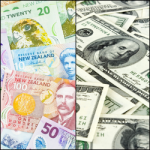Yesterday’s trade (in GMT terms) saw USD/CAD within the range of 1.3397-1.3539. The pair closed at 1.3422, losing 0.75% compared to Fridays close. It has been the 184th drop in the past 391 trading days and also the steepest one since November 15th. The daily low has been a level not seen since November 22nd, when a low of 1.3378 was registered. The major pair has trimmed its advance to 0.10% so far during the current month, following a 2.14% surge in October.
At 8:12 GMT today USD/CAD was inching up 0.03% on the day to trade at 1.3426. The pair touched a daily high at 1.3437 during mid-Asian trade, overshooting the daily R1 level, and a daily low at 1.3400 during the early phase of the Asian trading session.
On Tuesday USD/CAD trading may be influenced by the following macroeconomic reports and other events as listed below.
Fundamentals
United States
Gross Domestic Product – second estimate
The second estimate of the US Gross Domestic Product probably pointed to an annualized rate of growth of 3.0% in the third quarter of the year, according to market expectations, up from 2.9% in the preliminary release. If so, this would be the fastest annual rate of growth since the second quarter of 2015, when US economy grew at a final 3.9%. The final GDP estimate for Q2, reported on September 29th, pointed to an annual growth of 1.4%, a revision up compared to the second GDP estimate.
Consumer spending in the country rose at a preliminary annual rate of 2.1% in the third quarter of 2016, decelerating from a 4.3% surge in the second quarter. It contributed to 1.47 percentage points to overall growth in Q3.
Fixed investment contracted at a preliminary annual rate of 0.6% in Q3, improving from a 1.1% drop in the second quarter, as non-residential investment contracted 2.7% and residential investment decreased 6.2%. Fixed investment subtracted 0.09 percentage points from overall growth in Q3, according to preliminary data.
US exports grew at a preliminary annual rate of 10% in Q3, following a 1.8% increase in the second quarter, while marking their largest gain since Q4 2013. At the same time, US imports expanded at a preliminary 2.3% in the third quarter of 2016, accelerating from a 0.2% increase in the second quarter. Trade contributed to 0.83 percentage points to overall growth in Q3, according to the preliminary report by the US Bureau of Economic Analysis.
In case the second GDP estimate met or even outpaced expectations, this would certainly boost the US Dollar. The revised data are due out at 13:30 GMT.
Fed speakers
At 12:45 GMT Federal Reserve Vice Chair, Stanley Fischer, is scheduled to attend The Clearing House annual conference in New York.
At 14:15 GMT the Fed President for New York, William Dudley, is expected to speak on opportunities for economic growth in Puerto Rico, in San Juan (Puerto Rico).
Economic outlook or monetary policy-related remarks would heighten USD volatility.
S&P Case-Shiller Home Price Index
At 14:00 GMT Standard & Poor’s/Case-Schiller will report on the performance of their House Price Index, which measures the change in values of single-family homes in 20 metropolitan areas across the United States. The report serves as a gauge of the US housing market’s health. According to the median estimate by experts, home prices in the 20 areas probably rose 5.2% in September compared to September 2015. If so, it would be the largest annual increase since May. In August, home prices rose 5.1% year-on-year. During the month, home values in Portland recorded the highest annual increase (up 11.7%), followed by Seattle (up 11.4%) and Denver (up 8.8%). Within a recovering economy, a sharper-than-projected gain in prices will usually have a limited-to-moderate bullish effect on the local currency.
Consumer Confidence Index by the CB
Confidence among consumers in the United States probably improved in November, with the corresponding index coming in at a reading of 101.2, according to market expectations. In October, the gauge was reported at 98.6, while exceeding the median analyst estimate pointing to a lesser slowdown (to 101.0). It has been the lowest level of confidence since July, when the gauge came in at a revised down level of 96.7 (97.3 previously).
This indicator measures the level of individuals’ confidence in the US economic development. It is considered as a leading indicator, as it gives an early insight into consumer spending, which accounts for a major part of the nation’s GDP.
In case the index rebounded at a steeper rate than anticipated in November, this would have a strong bullish effect on the US dollar, as higher confidence, in general, suggests a greater willingness to spend and, respectively, a higher economic growth. The Conference Board research group is to release the official report at 15:00 GMT.
Bond Yield Spread
The yield on Canada’s 2-year government bonds went up as high as 0.676% on November 28th, after which it closed at 0.660% to lose 1 basis point (0.01 percentage point) compared to November 25th.
Meanwhile, the yield on US 2-year government bonds climbed as high as 1.131% on November 28th, after which it fell to 1.103% at the close to lose 2.4 basis points (0.024 percentage point) compared to November 25th.
The spread between 2-year US and 2-year Canadian bond yields, which reflects the flow of funds in a short term, narrowed to 0.443% on November 28th from 0.457% on November 25th. The November 28th yield spread has been the lowest one since November 22nd, when the difference was 0.439%.
Daily, Weekly and Monthly Pivot Levels
By employing the Camarilla calculation method, the daily levels of importance for USD/CAD are presented as follows:
R1 – 1.3435
R2 – 1.3448
R3 (Range Resistance – Sell) – 1.3461
R4 (Long Breakout) – 1.3500
R5 (Breakout Target 1) – 1.3546
R6 (Breakout Target 2) – 1.3564
S1 – 1.3409
S2 – 1.3396
S3 (Range Support – Buy) – 1.3383
S4 (Short Breakout) – 1.3344
S5 (Breakout Target 1) – 1.3298
S6 (Breakout Target 2) – 1.3280
By using the traditional method of calculation, the weekly levels of importance for USD/CAD are presented as follows:
Central Pivot Point – 1.3479
R1 – 1.3581
R2 – 1.3638
R3 – 1.3740
R4 – 1.3841
S1 – 1.3422
S2 – 1.3320
S3 – 1.3263
S4 – 1.3205
In monthly terms, for USD/CAD we have the following pivots:
Central Pivot Point – 1.3283
R1 – 1.3560
R2 – 1.3711
R3 – 1.3988
R4 – 1.4265
S1 – 1.3132
S2 – 1.2855
S3 – 1.2704
S4 – 1.2553





